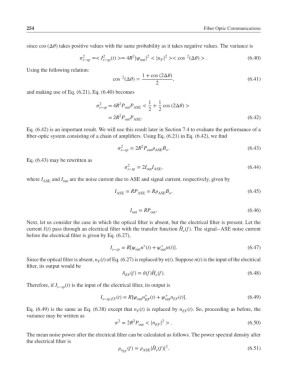Page 273 - Fiber Optic Communications Fund
P. 273
254 Fiber Optic Communications
since cos (Δ) takes positive values with the same probability as it takes negative values. The variance is
2
2
2
2
2 =< I 2 (t) >= 4R | | < |n | >< cos (Δ) >. (6.40)
s−sp s−sp out F
Using the following relation:
1 + cos (2Δ)
2
cos (Δ)= , (6.41)
2
and making use of Eq. (6.21), Eq. (6.40) becomes
2 2 1 1
= 4R P P < + cos (2Δ) >
s−sp out ASE
2 2
2
= 2R P P . (6.42)
out ASE
Eq. (6.42) is an important result. We will use this result later in Section 7.4 to evaluate the performance of a
fiber-optic system consisting of a chain of amplifiers. Using Eq. (6.21) in Eq. (6.42), we find
2
2
s−sp = 2R P B . (6.43)
out ASE o
Eq. (6.43) may be rewritten as
2 = 2I I , (6.44)
s−sp out ASE
where I ASE and I out are the noise current due to ASE and signal current, respectively, given by
B ,
I ASE = RP ASE = R ASE o (6.45)
I out = RP . (6.46)
out
Next, let us consider the case in which the optical filter is absent, but the electrical filter is present. Let the
̃
current I(t) pass through an electrical filter with the transfer function H (f). The signal–ASE noise current
e
before the electrical filter is given by Eq. (6.27),
∗
∗
I s−sp = R[ n (t)+ n(t)]. (6.47)
out
out
Since the optical filter is absent, n (t) of Eq. (6.27) is replaced by n(t). Suppose n(t) is the input of the electrical
F
filter, its output would be
̃
ñ (f)= ñ(f)H (f). (6.48)
EF
e
Therefore, if I s−sp (t) is the input of the electrical filter, its output is
∗
∗
I (t)= R[ n (t)+ n (t)]. (6.49)
s−sp,EF out EF out EF
Eq. (6.49) is the same as Eq. (6.38) except that n (t) is replaced by n (t). So, proceeding as before, the
F EF
variance may be written as
2
2
2
= 2R P < |n | >. (6.50)
out EF
The mean noise power after the electrical filter can be calculated as follows. The power spectral density after
the electrical filter is
2
̃
(f)= ASE |H (f)| . (6.51)
e
n EF

